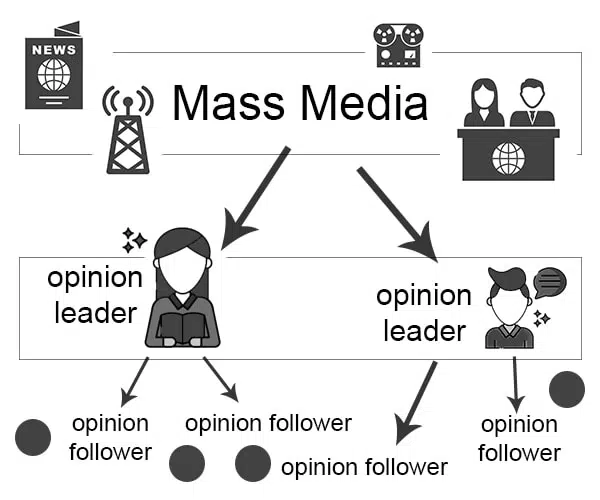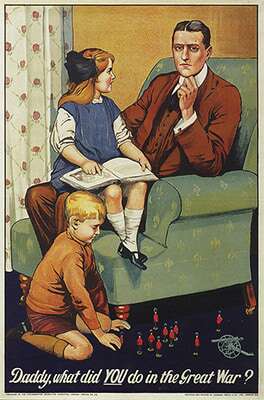Two-Step Flow Theory
Explore how messages are communicated to opinion followers through important opinion leaders.
Introduction
During the 1940 American presidential election campaign, Paul Lazarsfeld directed a study into the decision-making process of voters. His team interviewed 600 people from the state of Ohio and documented the psychological and social factors influencing their choice on the ballot paper in the months leading up to Election Day. The sample was expanded nationwide for the 1944 election with two thousand more voters included in the study.
Their analysis suggested that only five per cent of voters changed their preference because of the candidate’s appearance in newspapers and on the radio. In other words, the mass media’s direct influence on the audience was very limited.
Lazarsfeld argued that information shared between friends and family had the most profound impact on a person’s voting behaviour. An opinion leader would interpret the speeches broadcast on the radio or the advertisements printed in the newspaper. They would then persuade other voters with less political knowledge on which way they should cast their ballot.
Contents
The Theory
The research, first published in 1944, concluded that interpersonal communication played a more significant role in the decision-making process rather than exposure to the media. This model of communication became known as the Two-step Flow Theory.

In this process of communication, the mass media broadcast values and ideologies but the information is filtered and synthesised by opinion leaders who then share their own interpretations with opinion followers. For example, Lazarsfeld cited a waitress who overheard “many customers in the restaurant” claiming “Willkie would be no good” so she voted for Roosevelt. One respondent said “I hear men talk at the shop” and another mentioned “my husband heard that talked about at work”.
In fact, there were several clear cases when the political issues or candidates’ personalities had no impact on the voter. One interviewee said her friends “all voted Republican so I did too”.
The researchers argued the propaganda was aimed at “the whole target” and not the individuals at the “centre” so politicians should try to persuade the opinion leaders because that is the most effective method of delivering their message to the whole audience.
Modern Definition
Analysing and summarising the research project and other surveys, Paul Lazarsfeld and Elihu Katz delivered their definition of the two-step flow of communication in 1955.
The two-step flow model continues to gather support from many critics, especially those who broaden the concept of opinion leaders to include prominent celebrities, journalists and bloggers voicing their opinions about contemporary issues. Debate has also centred around whether opinion leaders are they reinforcing the opinions of mass media or attempting to reshape the message according to their own framework of knowledge. In other words, are they sharing ideas or giving their own opinions.
Among Us
“Among Us” is a social deduction game set in space where players are tasked either to discover the enemies among the crew or, as one of these impostors, try to sabotage the ship and kill the crew mates.
Since its release on Android and iOS in June 2018, the developers offered regular updates, such as new skins, customisations and two additional maps. An online multiplayer option was added and cross-platform play was soon supported. However, after a lack of mainstream success, in January 2020, Innersloth decided to end the life of their game and not offer any further updates.
In July 2020, several well-known Twitch streamers, such as Sodapoppin and xQc, began playing it to their audiences and the game surged in popularity. By September 2020, “Among Us” had been downloaded a very impressive 100 million times.
The two-step flow theory can help explain this incredible increase in the game’s playerbase. The Twitch streamers acted as the opinion leaders who shared their enthusiasm for “Among Us” to their loyal opinion followers and, consequently, the sales of the game rocketed.
Ryan’s World
With over 26 million subscribers, Ryan Kaji and his family are very influential opinion leaders. Their toy reviews, often called unboxing videos, are mostly paid product recommendations but revenue is also generated from the pre-roll advertising, which has earned the young boy millions of dollars.
His deals with third-party brands are perfect examples of the two-step flow theory. Consider this video which promotes McDonald’s, Starbucks and Chick-fil-A.
Notice how the video lasts just over ten minutes. In recent years, it has become a trend to make longer YouTube videos and there are a number of reasons for this change. Most importantly, this should help increase watch time, which is the main ranking factor on the network’s algorithm. At ten minutes, YouTube will also allow you to insert mid-roll advertisements.
Opinion Leaders and Followers
In 1957, Elihu Katz offered further insight into what made an effective opinion leader. He suggested opinion leaders are competent in their profession and eager to share their ideas to their social network. For the flow of communication to work, the opinion leader and opinion follower should also share the same expression of values.
Propaganda
If the mass media are unable to inject a message into the audience, how does the two-step flow theory of communication help explain the success of the propaganda during the First World War?
You should consider the representation of the man in the image. Although it is an illustration, does it connect with opinion followers because of the clothes he is wearing and his 1910s haircut? In other words, is he relatable?
Think about other aspects of the mise-en-scene, such as the domestic setting conveyed by green armchair and the curtains. Do these signifiers help reinforce the representation of the common man?
Of course, you should also explore the tagline and how it anchors our interpretation of the message.

Final Thoughts
One of the best ways to develop your understanding of the two-step flow model of communication is to apply the theory to a variety of media texts. Swift’s endorsement of Diet Coke is a good example to get you started.
Stay Tuned
Curious about how audiences respond to media texts? The following articles explore how we interact and interpret the media.







